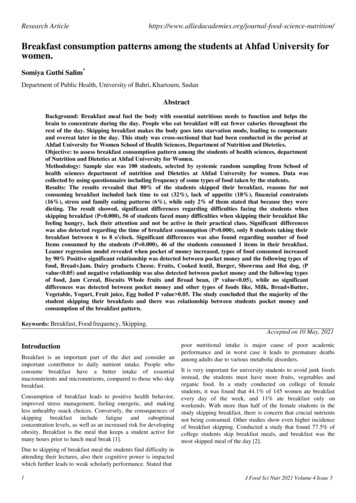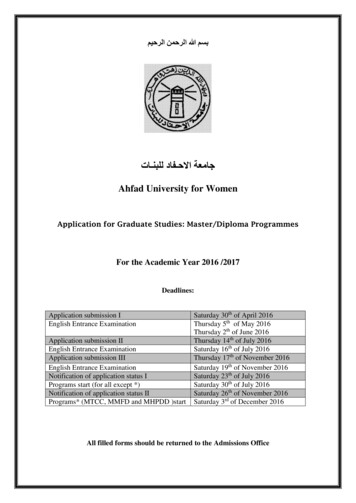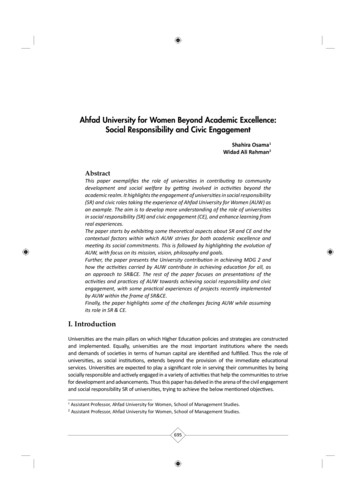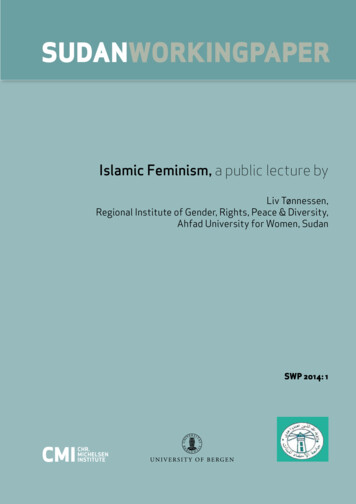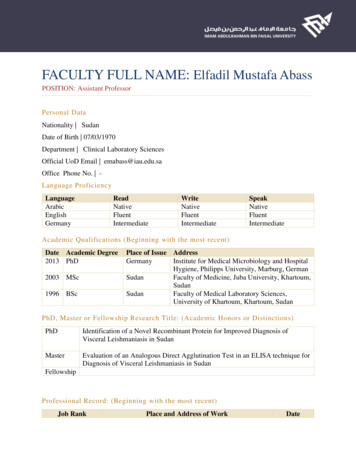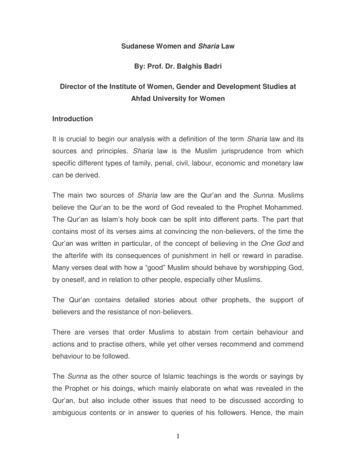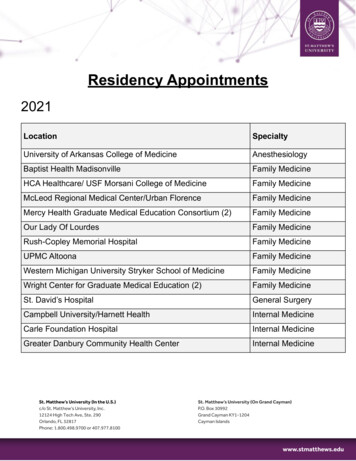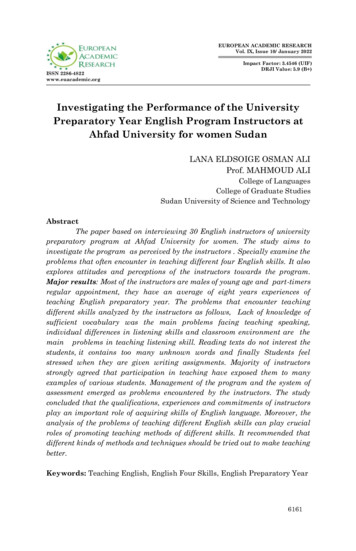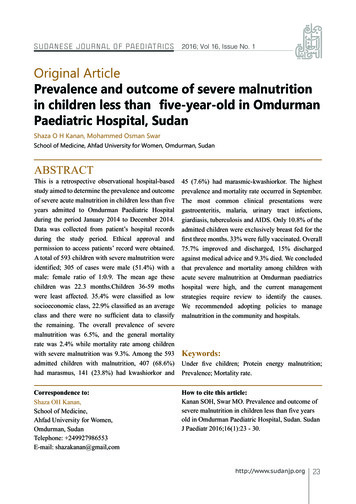
Transcription
S U D A N E S E J O U R N A L O F P A E D I AT R I C S2016; Vol 16, Issue No. 1Original ArticlePrevalence and outcome of severe malnutritionin children less than five-year-old in OmdurmanPaediatric Hospital, SudanShaza O H Kanan, Mohammed Osman SwarSchool of Medicine, Ahfad University for Women, Omdurman, SudanABSTRACTThis is a retrospective observational hospital-basedstudy aimed to determine the prevalence and outcomeof severe acute malnutrition in children less than fiveyears admitted to Omdurman Paediatric Hospitalduring the period January 2014 to December 2014.Data was collected from patient’s hospital recordsduring the study period. Ethical approval andpermission to access patients’ record were obtained.A total of 593 children with severe malnutrition wereidentified; 305 of cases were male (51.4%) with amale: female ratio of 1:0.9. The mean age thesechildren was 22.3 months.Children 36-59 mothswere least affected. 35.4% were classified as lowsocioeconomic class, 22.9% classified as an averageclass and there were no sufficient data to classifythe remaining. The overall prevalence of severemalnutrition was 6.5%, and the general mortalityrate was 2.4% while mortality rate among childrenwith severe malnutrition was 9.3%. Among the 593admitted children with malnutrition, 407 (68.6%)had marasmus, 141 (23.8%) had kwashiorkor andCorrespondence to:Shaza OH Kanan,School of Medicine,Ahfad University for Women,Omdurman, SudanTelephone: 249927986553E-mail: shazakanan@gmail,com45 (7.6%) had marasmic-kwashiorkor. The highestprevalence and mortality rate occurred in September.The most common clinical presentations weregastroenteritis, malaria, urinary tract infections,giardiasis, tuberculosis and AIDS. Only 10.8% of theadmitted children were exclusively breast fed for thefirst three months. 33% were fully vaccinated. Overall75.7% improved and discharged, 15% dischargedagainst medical advice and 9.3% died. We concludedthat prevalence and mortality among children withacute severe malnutrition at Omdurman paediatricshospital were high, and the current managementstrategies require review to identify the causes.We recommended adopting policies to managemalnutrition in the community and hospitals.Keywords:Under five children; Protein energy malnutrition;Prevalence; Mortality rate.How to cite this article:Kanan SOH, Swar MO. Prevalence and outcome ofsevere malnutrition in children less than five yearsold in Omdurman Paediatric Hospital, Sudan. SudanJ Paediatr 2016;16(1):23 - 30.http://www.sudanjp.org23
S U D A N E S E J O U R N A L O F P A E D I AT R I C SINTRODUCTIONThe term Malnutrition covers a wide range of illnesses,including under nutrition, specific nutrient deficienciesand over nutrition. It kills, retards, cripples, blinds andimpairs human developments ontruly massive scaleworldwide [1]. Severe protein-energy malnutrition(PEM) is a leading cause of death among childrenyounger than five years of age. Malnutrition isclassified into two classical syndromes, marasmus(wasting syndrome) and kwashiorkor, or a mixture ofboth (marasmic-kwashiorkor).Children are the most nutritionally vulnerable groupespecially in the developing world. According tosurveys conducted between 1987 and 1998, two outof five of these children are stunted, one in three isunderweight and one in ten is wasted; the numbersvary considerably among regions. Annually, some 30million infants, around 82,000 every day, are bornwith intrauterine malnutrition growth retardationmainly due to poor maternal nutritional status. Thehighest level of stunting is found in Eastern Africa,where 48.1% of preschool children were affected inthe year 2000 [2]. In this part of the world stunting isincreasing at 0.08 % per year [2].Sudan is a one of eastern African countries, where in1993, the Ministry of Health and the National NutritionDepartment (NND) conducted a comprehensivenutrition survey in the states most affected bynutritional problems and displacement. The numbersof children covered by the survey in the selected stateswere 3600. The overall rate of malnutrition was foundto be 19.6% (6.80% severe, 12.8% moderate).According to the Sudan simple special surveymethodology (S3M) survey which is conducted jointlyby UNICEF and MOH in 2013, there is a mix of verydifferent realities across the country with high levelsof stunting (chronic malnutrition) and low levels ofcoverage for safe water and sanitation in some areas.Poor feeding practice is a problem across the country,with localities in Kassala and Gedaref states among24http://www.sudanjp.org2016; Vol 16, Issue No. 1the most critical. The Eastern region and the threeKordofan states have the lowest coverage of safedrinking water and sanitation facilities, while the RedSea, Blue Nile and the Darfur region show the highestprevalence of diarrhoea. The good news is that theuse of iodized salt has improved, reaching over 90%of households in some localities in Red Sea, SouthDarfur, Blue Nile and Kassala [3].The prevalence of malnutrition imposes significantcosts on the Sudanese economy as well as society.The high mortality due to malnutrition leads to theloss of the economic potential of the child. It affectschildren in many ways, predisposing them to differentinfectious diseases, psychosocial mal-development,and cognitive deficiencies. The cost of hospitaladmission and treatment in addition to parental daysoff work should not be ignored.Reducing malnutrition and its consequences is a globaland development goal as stated by the MillenniumDevelopment Goals (MDGs) and the Sudan Growthand Development Strategy (SGDS).This study targetsthe latter by providing information that may assist inimprovingcurrent available services for treatment ofsevere malnutrition.Although acute malnutrition is acknowledged as oneof the major health problems at Omdurman paediatricshospital, there is paucity of data on the prevalence andoutcome of this condition in the hospital. Therefore,the objectives of this study was to determine theprevalence of acute severemalnutrition, and outcomesof severely malnourished children less than five yearsold admitted to Omdurman paediatrics Hospitaland to provide recommendations for improvementaccordingly.MATERIALS ANDMETHODSStudy settingsOmdurman Paediatric Hospital
S U D A N E S E J O U R N A L O F P A E D I AT R I C S2016; Vol 16, Issue No. 1Omdurman is the largest city in Sudan, lying onthe western banks of the River Nile. Omdurman,Khartoum and Khartoum North form the capital ofSudan, Khartoum State. Omdurman has a populationof 2,395,159 as per 2008 national census and is thenational centre of commerce. Omdurman PaediatricHospital is the biggest public teaching hospital inSudan, established in 1986 in an area of 6000 m 2withbed capacity of 290 beds.malnutrition in 2014 were included. Those withchronic illness in addition to severe malnutrition wereexcluded (e.g cardiovascular disease, tuberculosis,cerebral palsy, microcephaly or sickle cell disease).Ethical considerationsEthical approval was obtained from the hospitaladministration board to review patient’s records at thehospital statistical office.Statistical analysisData were analysed using SPSS version 19.MethodsThis is a oneyear (January 2014 - December 2014)retrospective, quantitative and hospital based study.We identified cases of PEM from hospital registers andobtained relevant information of the study populationfrom patient’s hospital records. These informationinclude type of PEM (marasmus, kwashiorkor, ormarasmic- kwashiorkor), date of admission anddischarge, history of breast feeding, socioeconomicstatus of the care-giver, associated comorbidities, vaccination history, and the outcome(improved and discharge, discharge against medicaladvice or died).Inclusion and exclusion criteriaAll children with age less than 5-year-old admittedto Omdurman Paediatric hospital with severeRESULTSIn 2014 a total of 13,352 children were admitted toOmdurman Paediatrics Hospital of which 9,157 wereunder 5years of age. 610 of these were admittedbecause of severe acute malnutrition this represent4.6% of total hospital admissions and 6.7% of underfive admissions. 17 out of the 610 were excluded asper study protocol. The total of under-five childrenaffected by acute severe malnutrition in 2014 was593; of these 305 were males (51.4%), giving a male:female ratio of 1: 0.9 (Figure 1). The mean age ofchildren admitted with acute severe malnutrition were22.3months. Children aged 36-59 months wereleastaffected as shown in Table 1.Figure 1 - Gender distribution of children less than 5-year-old admitted withmalnutrition during the year 2014 to Omdurman Paediatric Hospital.http://www.sudanjp.org25
S U D A N E S E J O U R N A L O F P A E D I AT R I C S2016; Vol 16, Issue No. 1Table 1 - Distribution of children according to age group with protein-energymalnutrition admitted to Omdurman Paediatric Hospital during the year 2014Age group 01045344593During the study period the overall prevalenceof severe malnutrition was 6.5%, and the generalmortality rate at the hospital was 2.4%, while thePercent23.1042.1517.549.787.42100mortality rate among the children with acute severePEM was 9.3% (Figure 2).Figure 2 - Prevalence and mortality rate among children less than 5-year- old admitted withmalnutrition during 2014.Among the 593 admitted children with severemalnutrition, 397(68.6%) had marasmus, 141(23.8%)26http://www.sudanjp.orghad kwashiorkor and only 45 (7.6%) were marasmickwashiorkor (Figure 3).
S U D A N E S E J O U R N A L O F P A E D I AT R I C S2016; Vol 16, Issue No. 1Figure 3 - Distribution of different types of malnutrition among children less than 5-year- oldduring 2014.Seasonal variations in the prevalence PEM amongadmitted children was observed with 52% inautumn (June – September). The most commonclinical presentations among the under five childrenadmitted with PEM during the year 2014 weregastroenteritis, malaria, urinary tract infection andGiardiasis. Regarding breast-feeding only 10.8%were exclusively breast fed for the first three monthsof life, 8.6% exclusive breast fed but the duration wasnot known. On the other hand, 0.8% was exclusivelybottle fed, while 33.4% had mixed feed but theduration is not known as shown in Table 2.Table 2 - Types and duration of feedingTypeExclusive breast feeding for three monthsExclusive breast feedingBottle feedingMixed feedingNo informationTotalFully vaccinated children represented only 33%, while30% were not vaccinated and 18.6% were 8433.4046.37100vaccinated and no data was available for 18% of thechildren (Table 3).http://www.sudanjp.org27
S U D A N E S E J O U R N A L O F P A E D I AT R I C S2016; Vol 16, Issue No. 1Table 3 - Vaccination status among children admitted with malnutrition during the year 2014Vaccination statusFull vaccinatedPartially vaccinatedNot vaccinatedTotalFrequency198110285593The majority (75.7%) of the study populationrecovered and were discharged from the hospital,Percent33.3818.5548.07100while 15% were discharged against medical adviceand 9.3% died as shown in Table 4.Table 4 - Outcome of children admitted with malnutrition during the year 2014StatusImproved and dischargeDischarged against medical adviceDiedTotalFrequency4498955593Data about the socio-economic status of children’sfamily showed that 35.4% of the families wereclassified as low socio-economic class and 22.9%Percent75.7215.019.27100were classified as an average class family. No datawas available to classify the rest of the cases (Table5).Table 5 - Socioeconomic status of children’s familiesStatusLowAverageNot mentionedTotalDISCUSSIONNumber210136247593This is a retrospective observational study; involvingchildren less than 5 years of age admitted withmalnutrition to Omdurman Paediatrics Hospitalduring the year 2014. Males and females were affectedequally. These results are similar to the findings ofUbesie et al [4] and Cartmell et al [7] who reporteda mean age of 21.7 months in under-five years oldchildren admitted with PEM, while the mean age ofthe children in our study was 22.3 months. Two 65100(65%) of the affected children were younger than 24months (Table 1). Two studies by Gernaat et al [5] andNnakwe [6] reported similar findings. It is apparentthat children under 2 years of age are the most affectedage group. This could be due to a number of factorsincluding low rate of exclusive breast feeding asdocumented in this study as well as poor weaning andfeeding practices. Marasmus was the most commontype of PEM noted in this study, affecting more thantwo thirds of the study population (66.9%). Similar
S U D A N E S E J O U R N A L O F P A E D I AT R I C S2016; Vol 16, Issue No. 1results were reported by Gernaat et al [5]. Anotherstudy by Cartmell et al [7] reported kwashiorkor andmarasmus as the most common types of PEM amongadmitted children in 1983, while the situation waschanged to kwashiorkor and marasmic-kwashiorkorin 2001 in the same area.The overall mortality in this study was 9.3%. Certainlythis is a very high percentage although it seems lowwhen compared with different studies conductedin various parts of Africa. In Oshogbo, South WestNigeria, Ibekwe and Ashworth [8] documented anaverage mortality rate of 22% over a five-year-periodamong 803 children admitted with PEM in a nutritionalrehabilitation centre. Another hospital-based study inZambia involving 288 children below 5 years of agereported an overall mortality rate of 25.8% [5]. Themean duration of length of hospital stay was 9 days,which was lower than that reported by Cartmell et al[7] and Ubesie et al [4] (13 and 16 days, respectively).The pressure on bed spaces in Omdurman PaediatricHospital could have contributed to earlier dischargesthan in other hospitals. Although information aboutsocioeconomic status were documented in only346 cases in our study, still PEM was predominantamong children from lower social class (35.4%).Similar high percentage was reported by Ubesie etal [4]. This may be due to the fact that poor familieshave low purchasing power for adequate nutritiousfood. Illiteracy may also influence feeding practices.Poverty and illiteracy as risk factors for PEM havebeen well documented in the literature. Nahar et al[9] found that severely underweight children are morelikely to have undernourished poorly educated youngmothers, short duration of predominant breastfeeding,and poorly educated unskilled fathers.The commonest co-morbidities associated with PEMin this study were gastroenteritis, malaria, anaemia,urinary tract infections and giardiasis; similar to thosereported in other studies [4].Benefits of exclusive breastfeeding have been wildlyacknowledged. They are known to promote sensoryand cognitive development, and protect the infantagainst infectious and chronic diseases. Exclusivebreastfeeding reduces infant mortality due to commonchildhood illnesses such as diarrhoea or pneumonia,and provide immunoglobulins which helps in aquicker recovery during illness. In the present studyonly 10.8% were exclusively breast fed for threemonths, 8.6% had exclusive breast feeding but forunknown duration, 0.8% were bottle fed, 33.4% hadmixed feeding and no data was available in almosthalf of the children (46.4%).There is a strong association between vaccination andmalnutrition, as the role of vaccination in preventingcontagious diseases cannot be over-emphasized. Lackof vaccination, fully or partially may be a predisposingfactor for malnutrition as shown by a study in Uganda[10]. Lack of vaccination is linked to low socioeconomic class, less education, and major family andsocial problems like divorce, unemployment or deathof a parent etc. In this study only 33% were fullyvaccinated, 30% of children were not vaccinated,18.6% were partially vaccinated and 18% had noavailable data regarding their vaccination history.CONCLUSIONSOur study showed a high prevalence of severemalnutrition among children less than 24 monthsof age. Seasonal variation in the prevalence ofmalnutrition among the under five-year-old childrenwas noticed, with high prevalence in autumn (June toSeptember) with increased mortality rate during thisperiod. The predominant type of malnutrition amongour cohort was marasmus.We recommend adopting policies to promoteexclusive breastfeeding for the first six months oflife with continuation of breastfeeding in additionto complementary feeding for up to 24 months oflife. Focusing on health education, access to locallyhttp://www.sudanjp.org29
S U D A N E S E J O U R N A L O F P A E D I AT R I C S2016; Vol 16, Issue No. 1available age-appropriate food, and improving watersupply and sanitation systems and hygiene practicesto protect children against communicable diseases,are the main recommendations of this study. We alsorecommend thorough review to identify reasons ofthe observed high mortality in Omdurman PaediatricsHospital.REFRENCESWorld Health Organization. Report on malnutrition worldwide. WHO, Geneva.2000UNICEFPlan of operation in cooperation with Ethiopian government 1994-1999.Federal Ministry of Health.Central Bureau of Statistics andUnicef. The 2000 Sudan Multiple Indicator ClusterSurvey, Sudan - Final Report.MICS2000 ;24. Ubesie AC1, Ibeziako NS, Ndiokwelu CI, Uzoka CM, Nwafor CA.Under-five protein energy malnutrition admittedatthe University of Nigeria Teaching Hospital,Enugu: a 10 year retrospective review. Nutr J 2012; 11:43- 50.5. Gernaat HB, Dechering WH,Voorhoeve WH. Mortality in severe protein-energy malnutrition at Nchelenge, Zambia.J Trop Pediatr 1998; 44(4):211– 217.6. Nnakwe N. The effect and causes of protein-energy malnutrition in Nigerian children. Nutr Res 1995; 15:785–794.7. Cartmell E, Natalal H, Francois I, Ferreira MH,Grahnquist L. Nutritional andclinical status of children admitted tothe malnutrition ward, MaputoCentral Hospital: A Comparison of data from 2001 and 1983. J Trop Pediatr 2005;51(2):102–105.8. Ibekwe VE, Ashworth A. Management of protein energy malnutrition inNigeria: an evaluation of the regimen at theKersey NutritionRehabilitation Centre, Nigeria. Trans R Soc Trop Med Hyg 1994; 88:594–595.9. Nahar B, Ahmed T, Brown KH, Hossain MI. Risk factors associated with severe underweight among young childrenreporting to a diarrhoea treatment facility in Bangladesh. J health PopulNutr 2010; 28(5):476–483.10. Owor M,Tumwine JK,Kikafunda JK.Socio-economic risk factors for severe protein energymalnutrition amongchildren in MulagoHospital,Kampala. East Afr Med J 2000;77(9): 471-4751.2.3.30http://www.sudanjp.org
Ahfad University for Women, Omdurman, Sudan Telephone: 249927986553 E-mail: shazakanan@gmail,com How to cite this article: Kanan SOH, Swar MO. Prevalence and outcome of severe malnutrition in children less than five years old in Omdurman Paediatric Hospital, Sudan. Sudan


